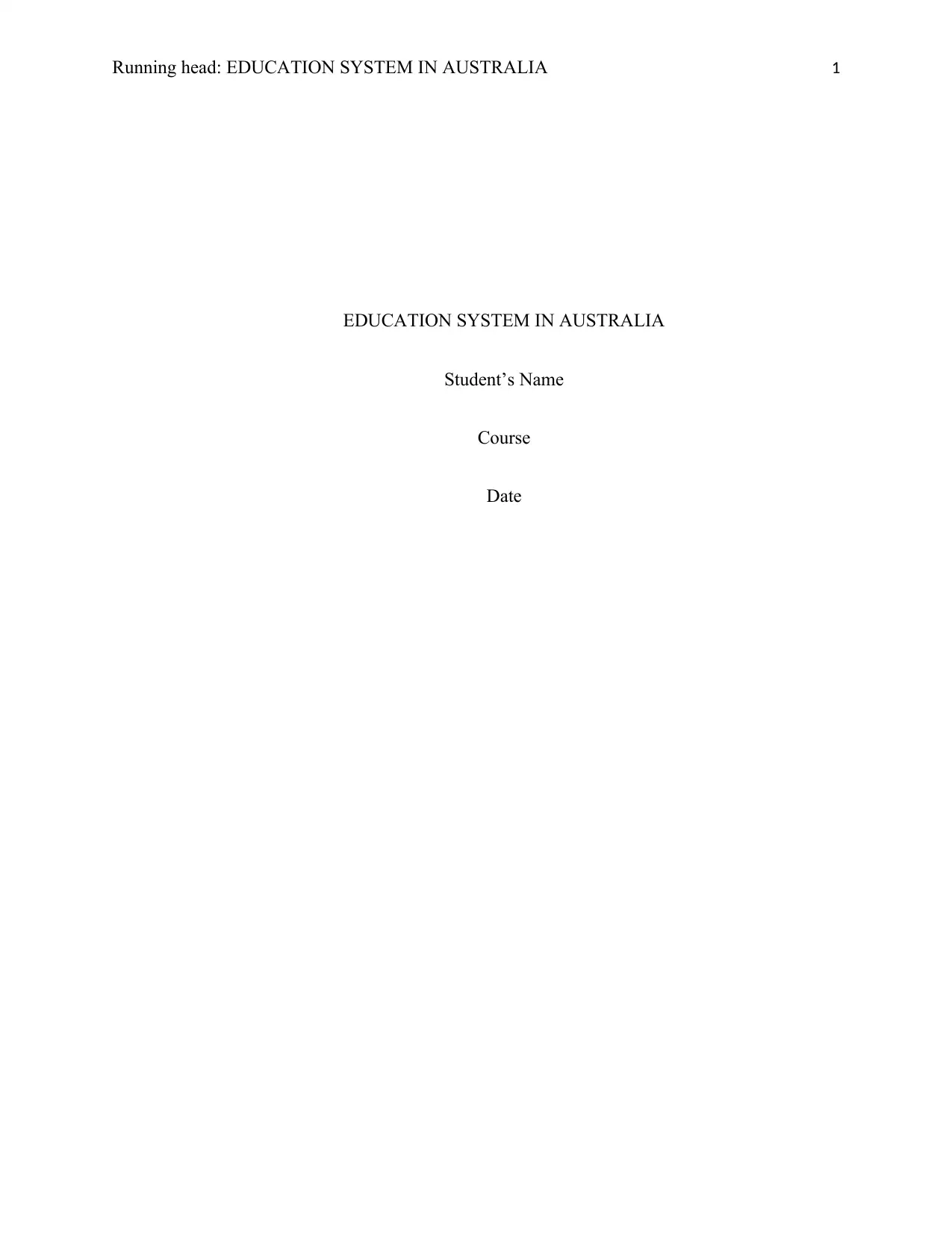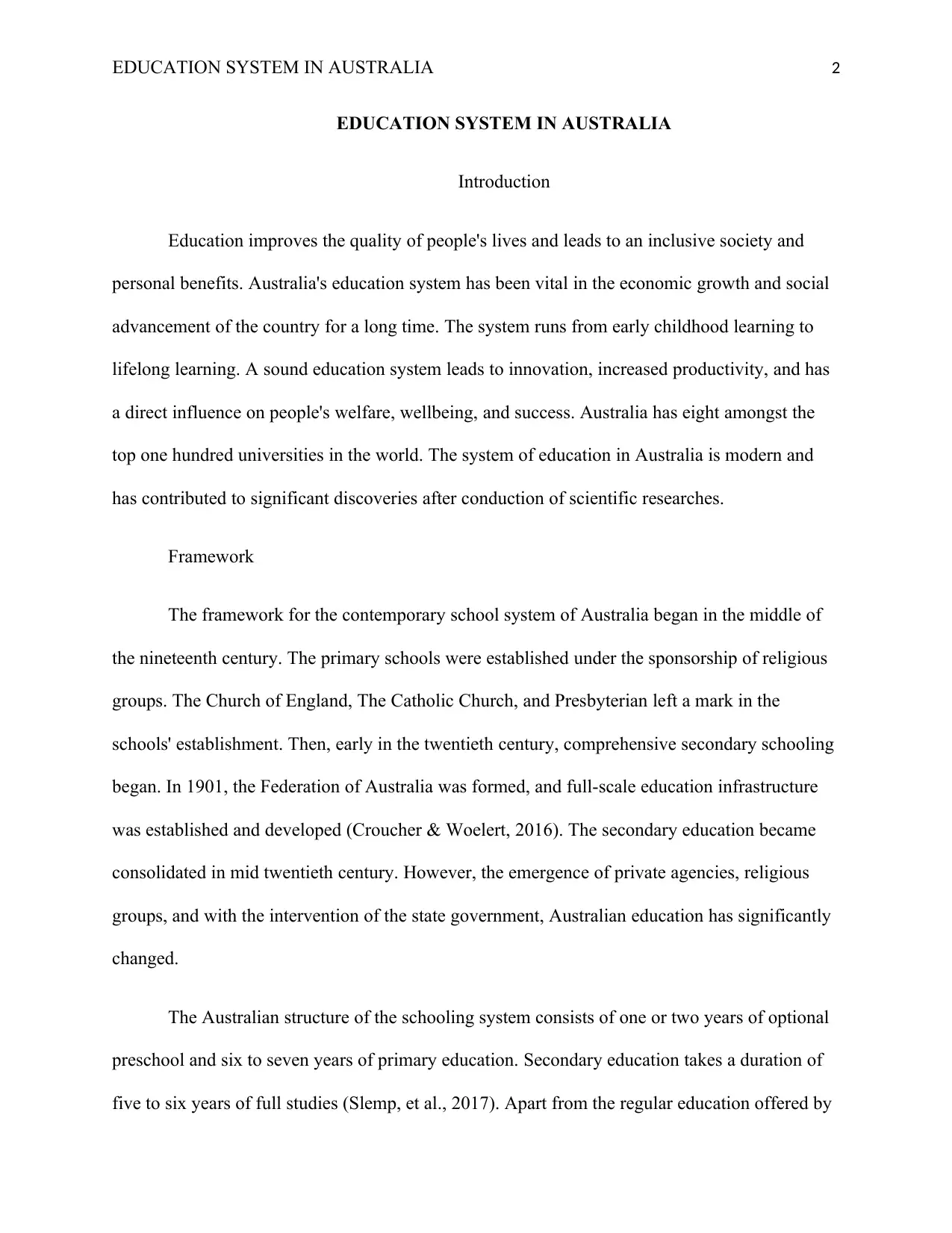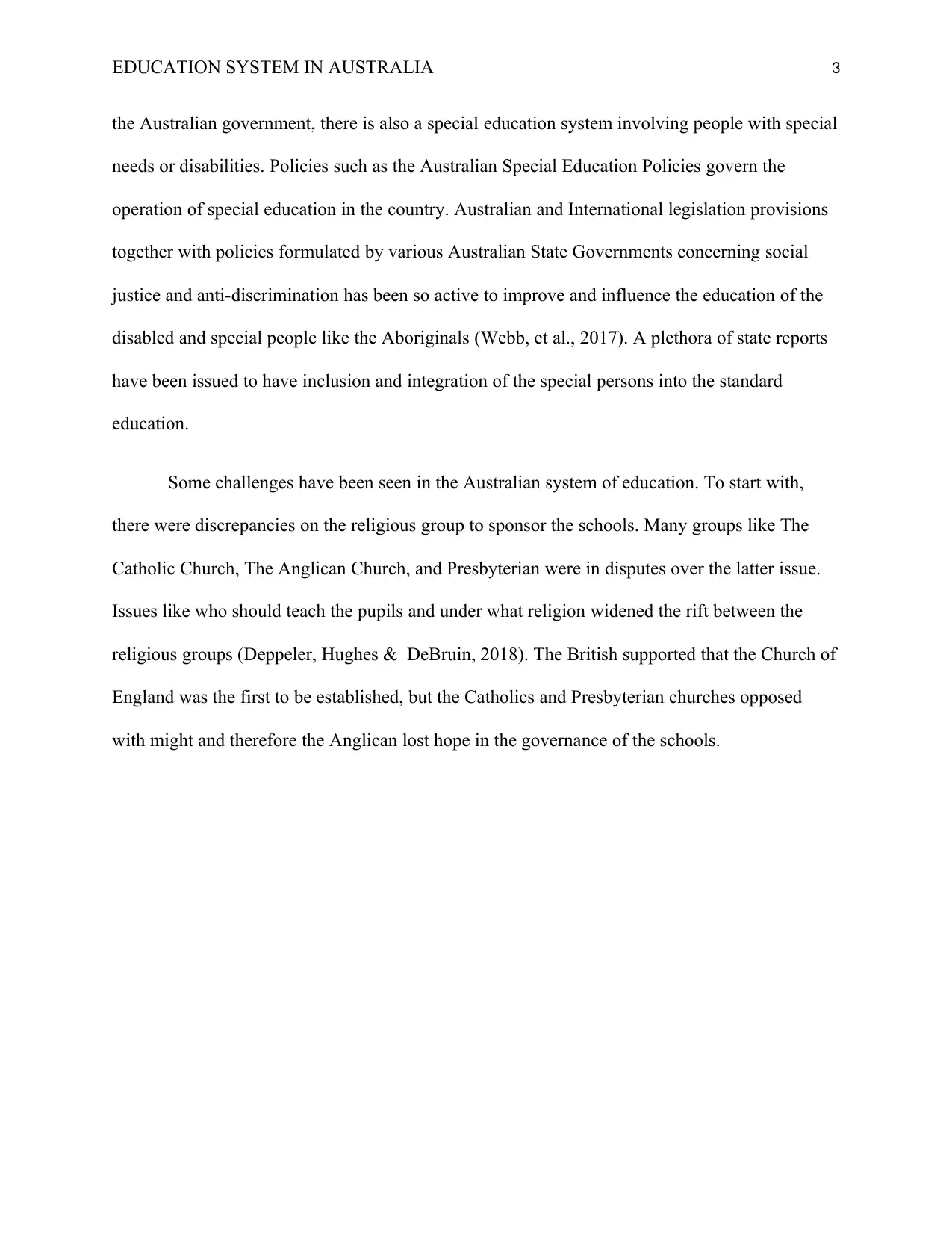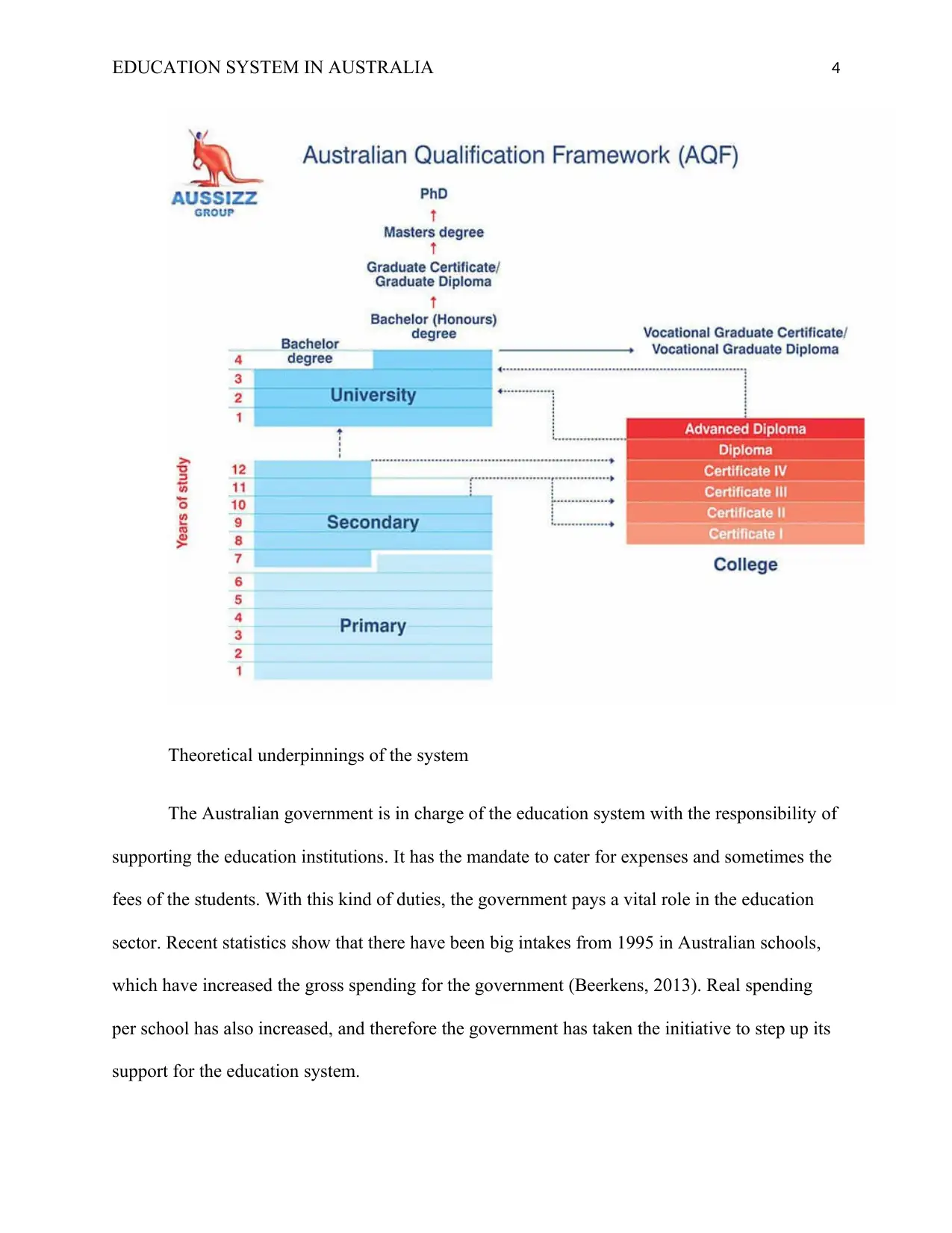Comprehensive Analysis of the Education System in Australia
VerifiedAdded on 2022/10/10
|7
|1297
|248
Essay
AI Summary
This essay provides a detailed overview of the education system in Australia, tracing its development from the mid-nineteenth century to the present day. It explores the framework of the system, including preschool, primary, and secondary education, as well as special education policies. The essay highlights the roles of religious groups, government, and various agencies in shaping the education landscape. It also discusses the theoretical underpinnings of the system, emphasizing the government's role in funding and governance. Furthermore, the analysis examines the impact of the education system on Australian society, including its contribution to economic growth and social advancement. The essay concludes by acknowledging the strengths of the Australian education system, while also pointing out areas for improvement to ensure future prosperity.

Running head: EDUCATION SYSTEM IN AUSTRALIA 1
EDUCATION SYSTEM IN AUSTRALIA
Student’s Name
Course
Date
EDUCATION SYSTEM IN AUSTRALIA
Student’s Name
Course
Date
Paraphrase This Document
Need a fresh take? Get an instant paraphrase of this document with our AI Paraphraser

EDUCATION SYSTEM IN AUSTRALIA 2
EDUCATION SYSTEM IN AUSTRALIA
Introduction
Education improves the quality of people's lives and leads to an inclusive society and
personal benefits. Australia's education system has been vital in the economic growth and social
advancement of the country for a long time. The system runs from early childhood learning to
lifelong learning. A sound education system leads to innovation, increased productivity, and has
a direct influence on people's welfare, wellbeing, and success. Australia has eight amongst the
top one hundred universities in the world. The system of education in Australia is modern and
has contributed to significant discoveries after conduction of scientific researches.
Framework
The framework for the contemporary school system of Australia began in the middle of
the nineteenth century. The primary schools were established under the sponsorship of religious
groups. The Church of England, The Catholic Church, and Presbyterian left a mark in the
schools' establishment. Then, early in the twentieth century, comprehensive secondary schooling
began. In 1901, the Federation of Australia was formed, and full-scale education infrastructure
was established and developed (Croucher & Woelert, 2016). The secondary education became
consolidated in mid twentieth century. However, the emergence of private agencies, religious
groups, and with the intervention of the state government, Australian education has significantly
changed.
The Australian structure of the schooling system consists of one or two years of optional
preschool and six to seven years of primary education. Secondary education takes a duration of
five to six years of full studies (Slemp, et al., 2017). Apart from the regular education offered by
EDUCATION SYSTEM IN AUSTRALIA
Introduction
Education improves the quality of people's lives and leads to an inclusive society and
personal benefits. Australia's education system has been vital in the economic growth and social
advancement of the country for a long time. The system runs from early childhood learning to
lifelong learning. A sound education system leads to innovation, increased productivity, and has
a direct influence on people's welfare, wellbeing, and success. Australia has eight amongst the
top one hundred universities in the world. The system of education in Australia is modern and
has contributed to significant discoveries after conduction of scientific researches.
Framework
The framework for the contemporary school system of Australia began in the middle of
the nineteenth century. The primary schools were established under the sponsorship of religious
groups. The Church of England, The Catholic Church, and Presbyterian left a mark in the
schools' establishment. Then, early in the twentieth century, comprehensive secondary schooling
began. In 1901, the Federation of Australia was formed, and full-scale education infrastructure
was established and developed (Croucher & Woelert, 2016). The secondary education became
consolidated in mid twentieth century. However, the emergence of private agencies, religious
groups, and with the intervention of the state government, Australian education has significantly
changed.
The Australian structure of the schooling system consists of one or two years of optional
preschool and six to seven years of primary education. Secondary education takes a duration of
five to six years of full studies (Slemp, et al., 2017). Apart from the regular education offered by

EDUCATION SYSTEM IN AUSTRALIA 3
the Australian government, there is also a special education system involving people with special
needs or disabilities. Policies such as the Australian Special Education Policies govern the
operation of special education in the country. Australian and International legislation provisions
together with policies formulated by various Australian State Governments concerning social
justice and anti-discrimination has been so active to improve and influence the education of the
disabled and special people like the Aboriginals (Webb, et al., 2017). A plethora of state reports
have been issued to have inclusion and integration of the special persons into the standard
education.
Some challenges have been seen in the Australian system of education. To start with,
there were discrepancies on the religious group to sponsor the schools. Many groups like The
Catholic Church, The Anglican Church, and Presbyterian were in disputes over the latter issue.
Issues like who should teach the pupils and under what religion widened the rift between the
religious groups (Deppeler, Hughes & DeBruin, 2018). The British supported that the Church of
England was the first to be established, but the Catholics and Presbyterian churches opposed
with might and therefore the Anglican lost hope in the governance of the schools.
the Australian government, there is also a special education system involving people with special
needs or disabilities. Policies such as the Australian Special Education Policies govern the
operation of special education in the country. Australian and International legislation provisions
together with policies formulated by various Australian State Governments concerning social
justice and anti-discrimination has been so active to improve and influence the education of the
disabled and special people like the Aboriginals (Webb, et al., 2017). A plethora of state reports
have been issued to have inclusion and integration of the special persons into the standard
education.
Some challenges have been seen in the Australian system of education. To start with,
there were discrepancies on the religious group to sponsor the schools. Many groups like The
Catholic Church, The Anglican Church, and Presbyterian were in disputes over the latter issue.
Issues like who should teach the pupils and under what religion widened the rift between the
religious groups (Deppeler, Hughes & DeBruin, 2018). The British supported that the Church of
England was the first to be established, but the Catholics and Presbyterian churches opposed
with might and therefore the Anglican lost hope in the governance of the schools.
⊘ This is a preview!⊘
Do you want full access?
Subscribe today to unlock all pages.

Trusted by 1+ million students worldwide

EDUCATION SYSTEM IN AUSTRALIA 4
Theoretical underpinnings of the system
The Australian government is in charge of the education system with the responsibility of
supporting the education institutions. It has the mandate to cater for expenses and sometimes the
fees of the students. With this kind of duties, the government pays a vital role in the education
sector. Recent statistics show that there have been big intakes from 1995 in Australian schools,
which have increased the gross spending for the government (Beerkens, 2013). Real spending
per school has also increased, and therefore the government has taken the initiative to step up its
support for the education system.
Theoretical underpinnings of the system
The Australian government is in charge of the education system with the responsibility of
supporting the education institutions. It has the mandate to cater for expenses and sometimes the
fees of the students. With this kind of duties, the government pays a vital role in the education
sector. Recent statistics show that there have been big intakes from 1995 in Australian schools,
which have increased the gross spending for the government (Beerkens, 2013). Real spending
per school has also increased, and therefore the government has taken the initiative to step up its
support for the education system.
Paraphrase This Document
Need a fresh take? Get an instant paraphrase of this document with our AI Paraphraser

EDUCATION SYSTEM IN AUSTRALIA 5
Although some explicit divisions exist in the system of the Australian government, there
is a defined system of education governance. “The primary responsibility for the school
education lies with the territorial government while Canberra is in charge of education and
training of Aboriginal and Torres Straits Islander Peoples, migrant education, international
partnerships in education, and for assistance for students” (Mazurek & Winzer, 2017). This
concludes that the Territorial Government and the Canberra have the most significant control
over the education system of Australia.
Impact on Australian Society
Australian education has a significant history and has continued to make marks under the
influence of different agencies and government. Starting from the religious significance,
government to Canberra influence, it can be noted that there is increased intervention by many
non-government and government weight (Parham, 2014). These influences have led to the
growth of education. On the contrary, some of the interventions have led to disputes and
retarding of schooling. The government of Australia believes that education will be the engine to
the country's future prosperity. The system seeks to build students with skills and confidence that
will improve the wellbeing of society.
Conclusion
Australia’s education is constructive, and the returns it gives back to the country have
brought huge reformations. The system's easiness to adapt to changes has enabled the
introduction of modern ways of learning through technology. However, a lot is needed to be
achieved in terms of student outcomes due to stiff international competitiveness. Action is
required in the education system for the sake of the coming generation, and this will guarantee
Although some explicit divisions exist in the system of the Australian government, there
is a defined system of education governance. “The primary responsibility for the school
education lies with the territorial government while Canberra is in charge of education and
training of Aboriginal and Torres Straits Islander Peoples, migrant education, international
partnerships in education, and for assistance for students” (Mazurek & Winzer, 2017). This
concludes that the Territorial Government and the Canberra have the most significant control
over the education system of Australia.
Impact on Australian Society
Australian education has a significant history and has continued to make marks under the
influence of different agencies and government. Starting from the religious significance,
government to Canberra influence, it can be noted that there is increased intervention by many
non-government and government weight (Parham, 2014). These influences have led to the
growth of education. On the contrary, some of the interventions have led to disputes and
retarding of schooling. The government of Australia believes that education will be the engine to
the country's future prosperity. The system seeks to build students with skills and confidence that
will improve the wellbeing of society.
Conclusion
Australia’s education is constructive, and the returns it gives back to the country have
brought huge reformations. The system's easiness to adapt to changes has enabled the
introduction of modern ways of learning through technology. However, a lot is needed to be
achieved in terms of student outcomes due to stiff international competitiveness. Action is
required in the education system for the sake of the coming generation, and this will guarantee

EDUCATION SYSTEM IN AUSTRALIA 6
future prosperity. Nevertheless, Australia’s level of education is amongst the best in the world
with an excellent reputation for having many international students through the Australian
Qualification Framework
future prosperity. Nevertheless, Australia’s level of education is amongst the best in the world
with an excellent reputation for having many international students through the Australian
Qualification Framework
⊘ This is a preview!⊘
Do you want full access?
Subscribe today to unlock all pages.

Trusted by 1+ million students worldwide

EDUCATION SYSTEM IN AUSTRALIA 7
References
Australian qualification framework [image]. (2019). Retrieved from
https://www.aussizzgroup.com/india/study-in-australia/education-system
Beerkens, M. (2013). Facts and fads in academic research management: The effect of
management practices on research productivity in Australia. Research Policy, 42(9),
1679-1693.
Croucher, G., & Woelert, P. (2016). Institutional isomorphism and the creation of the unified
national system of higher education in Australia: an empirical analysis. Higher
Education, 71(4), 439-453.
Deppeler, J., Hughes, R., & DeBruin, C. (2018). Enacting inclusive education policy across
and between levels within a decentralized education system in Australia. In European
Conference on Educational Research 2018.
Mazurek, K., & Winzer, M. A. (2006). Schooling around the world: Debates, challenges,
and practices. Boston, MA: Pearson/Allyn and Bacon.
Parham, D. (2014). Productivity and policy reform in Australia. International Productivity
Monitor, 5, 53-63.
Slemp, G. R., Chin, T. C., Kern, M. L., Siokou, C., Loton, D., Oades, L. G., ... & Waters, L.
(2017). Positive education in Australia: Practice, measurement, and future directions.
In Social and emotional learning in Australia and the Asia-Pacific (pp. 101-122).
Springer, Singapore.
Webb, S., Bathmaker, A. M., Gale, T., Hodge, S., Parker, S., & Rawolle, S. (2017). Higher
vocational education and social mobility: educational participation in Australia and
England. Journal of Vocational Education & Training, 69(1), 147-167.
References
Australian qualification framework [image]. (2019). Retrieved from
https://www.aussizzgroup.com/india/study-in-australia/education-system
Beerkens, M. (2013). Facts and fads in academic research management: The effect of
management practices on research productivity in Australia. Research Policy, 42(9),
1679-1693.
Croucher, G., & Woelert, P. (2016). Institutional isomorphism and the creation of the unified
national system of higher education in Australia: an empirical analysis. Higher
Education, 71(4), 439-453.
Deppeler, J., Hughes, R., & DeBruin, C. (2018). Enacting inclusive education policy across
and between levels within a decentralized education system in Australia. In European
Conference on Educational Research 2018.
Mazurek, K., & Winzer, M. A. (2006). Schooling around the world: Debates, challenges,
and practices. Boston, MA: Pearson/Allyn and Bacon.
Parham, D. (2014). Productivity and policy reform in Australia. International Productivity
Monitor, 5, 53-63.
Slemp, G. R., Chin, T. C., Kern, M. L., Siokou, C., Loton, D., Oades, L. G., ... & Waters, L.
(2017). Positive education in Australia: Practice, measurement, and future directions.
In Social and emotional learning in Australia and the Asia-Pacific (pp. 101-122).
Springer, Singapore.
Webb, S., Bathmaker, A. M., Gale, T., Hodge, S., Parker, S., & Rawolle, S. (2017). Higher
vocational education and social mobility: educational participation in Australia and
England. Journal of Vocational Education & Training, 69(1), 147-167.
1 out of 7
Related Documents
Your All-in-One AI-Powered Toolkit for Academic Success.
+13062052269
info@desklib.com
Available 24*7 on WhatsApp / Email
![[object Object]](/_next/static/media/star-bottom.7253800d.svg)
Unlock your academic potential
Copyright © 2020–2025 A2Z Services. All Rights Reserved. Developed and managed by ZUCOL.





